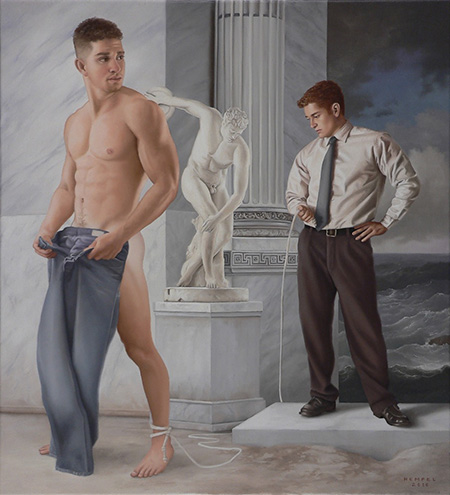
Continuing through February 25, 2017
In 1962 the United States Supreme Court ruled, in the case of MANual Enterprises v. Day, that nude male photographs are not obscene. Unless Donald Trump appoints judges intent on overriding that decision, gay artist Wes Hempel is likely to safely continue referencing images of men who look like himself onto his oil painted depictions of masculinity.
In an effort to screen them from homophobic social culture, one of Hempel’s predecessors, the late Tom of Finland, was effectively forced to publish his beefcake depictions of attractive, muscular young men in physical fitness and exercise magazines. Hempel turns instead to presenting his contemporary males as objects of desire by cleverly introducing them into validated, familiar looking, old master art historical settings. There he suggests that he is “able to imagine (and allow viewers to imagine) a past that includes rather than excludes gay experience by riding the coattails of art history's imprimatur.
Hempel’s work is both canny and worthy of leading viewers towards serious contemplation of related issues, including that of the goals of early feminists and their disdain for the male gaze, the depiction of nudity, sexuality and/or violence verses censorship in religious art and museum exhibitions. The contributions of artists such as Yoko Ono, Catherine Opie and Andy Warhol to this cause provide the historical ballast for Hempel and other contemporary gay artists.
Also on exhibit is Kal Mansur’s newest series of acrylic and Plexiglas constructions. Completely opposite from Hempel’s contributions in terms of media, subject matter and intention, Mansur’s work emulates geometric forms in architecture and pursues the minimalist objective of erasing all trace of the artist’s hand.
While directing light through the use of transparent, translucent and reflective materials, Mansur explores concepts that may well have concerned Robert Irwin in his 1980’s installation of skylights and sheer, semi-transparent scrim that transformed his studio workplace on Market Street in Venice California into a Light and Space icon. The results in works such as Mansur’s “Payne Plateau Two” and the bewitching “Charcoal Murmur 8” are galvanizing.
